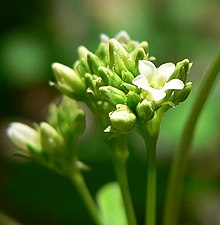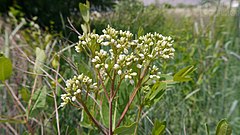|
Apocynum cannabinum
Apocynum cannabinum (dogbane, amy root, hemp dogbane, prairie dogbane, Indian hemp, rheumatism root, or wild cotton)[4] is a perennial herbaceous plant that grows throughout much of North America—in the southern half of Canada and throughout the United States. It is poisonous to humans, dogs, cats, and horses. All parts of the plant are toxic and can cause cardiac arrest if ingested. Some Lepidoptera feed on this plant, such as the hummingbird moth. DescriptionApocynum cannabinum grows up to 1 m (3 ft 3 in) tall. The stems are reddish and contain a milky latex. The leaves are opposite, simple broad lanceolate, 7–15 cm (2+3⁄4–6 in) long and 3–5 cm (1+1⁄4–2 in) broad, entire, and smooth on top with white hairs on the underside. It flowers from July to August, has large sepals, and a five-lobed white corolla. The flowers are hermaphrodite, with both male and female organs.[5]  TaxonomyEtymologyApocynum means "poisonous to dogs".[citation needed] The specific epithet cannabinum, and the common names hemp dogbane and Indian hemp refer to its similarity to Cannabis as a source of fiber.[6] It likely got its name from its resemblance to a European species of the same name.[which?][7] It is called qéemu [qǽːmu] in Nez Perce[8] and [taxʷɨ́s] in Sahaptin.[citation needed] The Maidu Concow people call the plant pö (Konkow language).[9] Distribution and habitatApocynum cannabinum grows in open wooded areas, ditches, and hillsides. It is found in gravelly or sandy soil, mainly near streams in shady or moist places.[5] It is native to much of North America—in the southern half of Canada and throughout the United States.[2] Ecology The plant serves as a larval host for the snowberry clearwing (Hemaris diffinis),[10] which is a pollinator that resembles a small hummingbird.[11] It is also a host plant for the dogbane tiger moth (Cycnia tenera) and the zebra caterpillar (Melanchra picta). The larvae of Marmara apocynella[10] feed on the stems, making a "long whitish serpentine mine".[12] ToxicityIt is poisonous to humans,[5] dogs, cats, and horses.[13] All parts of the plant are toxic, and the plant contains cardiac glycosides.[5] The plant is toxic both green and dried.[14] The stems contain a white sap capable of causing skin blisters.[15] UsesFiberMuch like flax and hemp, Apocynum cannabinum contains long fibers in the stems, known as bast fibers, which can be extracted and used to create textiles. The fibers are very fine and strong, with a silky texture, and easier to process than hemp.[6] The stalks of this plant have been used as a source of fiber by Native Americans[16] to make bows, fire-bows, nets, tie down straps, hunting nets, fishing lines, bags,[17] and clothing.[7] According to Craig Bates of the Yosemite Museum, five stalks of the plant are needed to make one foot of cordage. A large bag used for storing roots would take one to three months to complete.[18] The stems should be harvested in the fall, after the leaves have fallen and the stalks have turned a deep reddish-brown color. Since cutting the stalks promotes regrowth in the spring, as much as possible should be harvested. Unused stems are traditionally cleared away by burning, which causes the plant to grow back taller and straighter in spring. FoodThe seeds have an edible use as a meal (raw or cooked) when ground into a powder.[5] Chewing gumThe plant's latex sap can be squeezed from the plant and allowed to stand overnight to harden into a white gum which can be used (sometimes mixed with clean clay) as chewing gum.[5] PhytoremediationApocynum cannabinum can be used to sequester lead in its biomass by taking it up from the soil through its roots. This process, called phytoremediation, could help clean sites contaminated with lead.[19] Medicinal It is used in herbal medicine to treat fever and to slow the pulse.[20] Apocynum cannabinum has been employed by various Native American tribes to treat a wide variety of complaints including rheumatism, coughs, pox, whooping cough, asthma, internal parasites, diarrhea, and to increase lactation.[5] The root has been used as a tonic, cardiotonic, diaphoretic, diuretic, an emetic (to induce vomiting), and an expectorant.[20][5] It is harvested in the autumn and dried for later use. The fresh root is medicinally the most active part. A weak tea made from the dried root has been used for cardiac diseases and as a vermifuge (an agent that expels parasitic worms). The milky sap is a folk remedy for genital warts.[5] References
Further reading
External links |
||||||||||||||||||||||||||||||||||||||||||


